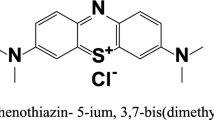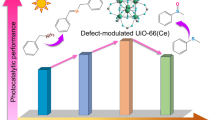Abstract
Herein, a novel visible-light-responsive photocatalyst with high efficiency was firstly synthesized at room temperature. The mild synthetic method resulted in a uniform spherical triazine-based covalent organic framework (TrCOF2) with ultra-high specific surface area as well as chemical stability. Due to the synergistic effect between the self-assembled uniform spherical structure and the abundant triazine-based structure, photoelectron–hole pairs were efficiently separated and migrated on the catalysts. On this basis, TrCOF2 was successfully applied to efficiently degrade bisphenol A (BPA). More than 98% of BPA was deraded after 60 min of visible light treatment, where the active specie of •O −2 played a vital role during the degradation of BPA. The holes of TrCOF2 could produce O2 by direct reaction with water or hydroxide ions. Simultaneously, photoelectrons can be captured by O2 to generate •O −2 . Moreover, density functional theory (DFT) calculations proved the outstanding ability of the exciting electronic conductivity. Remarkably, a reasonable photocatalytic mechanism for TrCOF2 catalysts was proposed. This research can provide a facile strategy for the synthesis of TrCOFs catalysts at room temperature, which unfolds broad application prospects in the environmental field.
Similar content being viewed by others
References
Zhang S, Gu P, Ma R, et al. Recent developments in fabrication and structure regulation of visible-light-driven g-C3N4-based photocatalysts towards water purification: a critical review. Catalysis Today, 2019, 335: 65–77
Chen P, Di S, Qiu X, et al. One-step synthesis of F-TiO2/g-C3N4 heterojunction as highly efficient visible-light-active catalysts for tetrabromobisphenol A and sulfamethazine degradation. Applied Surface Science, 2022, 587: 152889
Yu S, Tang H, Zhang D, et al. MXenes as emerging nanomaterials in water purification and environmental remediation. Science of the Total Environment, 2022, 811: 152280
Chen J, Tong T, Yang Y, et al. In-situ active Bisphenol A-degrading microorganisms in mangrove sediments. Environmental Research, 2022, 206: 112251
Ning T, Yang H, Shi C, et al. An in vitro assessment for human skin exposure to parabens using magnetic solid phase extraction coupled with HPLC. Chemosphere, 2022, 286: 131593
Tang H, Li R, Fan X, et al. A novel S-scheme heterojunction in spent battery-derived ZnFe2O4/g-C3N4 photocatalyst for enhancing peroxymonosulfate activation and visible light degradation of organic pollutant. Journal of Environmental Chemical Engineering, 2022, 10(3): 107797
Li Q, Chen Z, Wang H, et al. Removal of organic compounds by nanoscale zero-valent iron and its composites. Science of the Total Environment, 2021, 792: 148546
Barboza L G A, Cunha S C, Monteiro C, et al. Bisphenol A and its analogs in muscle and liver of fish from the North East Atlantic Ocean in relation to microplastic contamination. Exposure and risk to human consumers. Journal of Hazardous Materials, 2020, 393: 122419
Chu A C, Sahu R S, Chou T H, et al. Magnetic Fe3O4@TiO2 nanocomposites to degrade bisphenol A, one emerging contaminant, under visible and long wavelength UV light irradiation. Journal of Environmental Chemical Engineering, 2021, 9(4): 105539
Qiu M, Liu L, Ling Q, et al. Biochar for the removal of contaminants from soil and water: a review. Biochar, 2022, 4(1): 19
Qiu M, Hu B, Chen Z, et al. Challenges of organic pollutant photocatalysis by biochar-based catalysts. Biochar, 2021, 3(2): 117–123
Wang X, Nag R, Brunton N P, et al. Human health risk assessment of bisphenol A (BPA) through meat products. Environmental Research, 2022, 213: 113734
Zhang H, Chen X, Zhang Z, et al. Highly-crystalline triazine-PDI polymer with an enhanced built-in electric field for full-spectrum photocatalytic phenol mineralization. Applied Catalysis B: Environmental, 2021, 287: 119957
Wang Q, Domen K. Particulate photocatalysts for light-driven water splitting: mechanisms, challenges, and design strategies. Chemical Reviews, 2020, 120(2): 919–985
Wang H, Wang H, Wang Z W, et al. Covalent organic framework photocatalysts: structures and applications. Chemical Society Reviews, 2020, 49(12): 4135–4165
Rodriguez-San-Miguel D, Montoro C, Zamora F. Covalent organic framework nanosheets: preparation, properties and applications. Chemical Society Reviews, 2020, 49(8): 2291–2302
Liang R R, Ru-Han A, Xu S Q, et al. Fabricating organic nanotubes through selective disassembly of two-dimensional covalent organic frameworks. Journal of the American Chemical Society, 2020, 142(1): 70–74
Yu J, Di S, Ning T, et al. Rational design and synthesis of magnetic covalent organic frameworks for controlling the selectivity and enhancing the extraction efficiency of polycyclic aromatic hydrocarbons. Mikrochimica Acta, 2020, 187(9): 531
Cote A P, Benin A I, Ockwig N W, et al. Porous, crystalline, covalent organic frameworks. Science, 2005, 310(5751): 1166–1170
Wang H, Qian C, Liu J, et al. Integrating suitable linkage of covalent organic frameworks into covalently bridged inorganic/organic hybrids toward efficient photocatalysis. Journal of the American Chemical Society, 2020, 142(10): 4862–4871
Wan Y, Wang L, Xu H, et al. A simple molecular design strategy for two-dimensional covalent organic framework capable of visible-light-driven water splitting. Journal of the American Chemical Society, 2020, 142(9): 4508–4516
Fan H, Mundstock A, Feldhoff A, et al. Covalent organic framework-covalent organic framework bilayer membranes for highly selective gas separation. Journal of the American Chemical Society, 2018, 140(32): 10094–10098
Chen W B, Wang L, Mo D Z, et al. Modulating benzothiadiazole-based covalent organic frameworks via halogenation for enhanced photocatalytic water splitting. Angewandte Chemie International Edition, 2020, 59(39): 16902–16909
Ma H, Liu B, Li B, et al. Cationic covalent organic frameworks: a simple platform of anionic exchange for porosity tuning and proton conduction. Journal of the American Chemical Society, 2016, 138(18): 5897–5903
Kong D, Han X, Xie J, et al. Tunable covalent triazine-based frameworks (CTF-0) for visible-light-driven hydrogen and oxygen generation from water splitting. ACS Catalysis, 2019, 9(9): 7697–7707
Kuhn P, Antonietti M, Thomas A. Porous, covalent triazine-based frameworks prepared by ionothermal synthesis. Angewandte Chemie International Edition, 2008, 47(18): 3450–3453
Di S, Wang J, Zhai Y, et al. Efficient activation of peroxymonosulfate mediated by Co(II)-CeO2 as a novel heterogeneous catalyst for the degradation of refractory organic contaminants: degradation pathway, mechanism and toxicity assessment. Journal of Hazardous Materials, 2022, 435: 129013
Wang Y, Yang W, Chen X, et al. Photocatalytic activity enhancement of core–shell structure g-C3N4@TiO2 via controlled ultrathin g-C3N4 layer. Applied Catalysis B: Environmental, 2018, 220: 337–347
Gao Q, Xu J, Wang Z, et al. Enhanced visible photocatalytic oxidation activity of perylene diimide/g-C3N4 n–n heterojunction via π–π interaction and interfacial charge separation. Applied Catalysis B: Environmental, 2020, 271: 118933
Qaraah F A, Mahyoub S A, Hezam A, et al. One step-polymerization for constructing 1D/2D oxygen doped g-C3N4 isotype heterojunctions with highly improved visible-light-driven photocatalytic activity. Journal of Environmental Chemical Engineering, 2021, 9(6): 106587
Yang S, Li X, Ma J, et al. Atomically dispersed Ru catalysts for polychlorinated aromatic hydrocarbon oxidation. Nanoscale, 2022, 14(21): 7849–7855
Chen P, Di S, Qiu X, et al. One-step synthesis of F-TiO2/g-C3N4 heterojunction as highly efficient visible-light-active catalysts for tetrabromobisphenol A and sulfamethazine degradation. Applied Surface Science, 2022, 587: 152889
Hastings A M, Ray D, Jeong W, et al. Advancement of actinide metal-organic framework chemistry via synthesis of Pu-UiO-66. Journal of the American Chemical Society, 2020, 142(20): 9363–9371
Junkaew A, Maitarad P, Arróyave R, et al. The complete reaction mechanism of H2S desulfurization on an anatase TiO2 (0 0 1) surface: a density functional theory investigation. Catalysis Science & Technology, 2017, 7(2): 356–365
Du W, Zhang Q, Shang Y, et al. Sulfate saturated biosorbent-derived Co-S@NC nanoarchitecture as an efficient catalyst for peroxymonosulfate activation. Applied Catalysis B: Environmental, 2020, 262: 118302
Bai X J, Sun C P, Wu S L, et al. Enhancement of photocatalytic performance via a P3HT-g-C3N4 heterojunction. Journal of Materials Chemistry A: Materials for Energy and Sustainability, 2015, 3(6): 2741–2747
Qin H, Zhang Y, He S, et al. Increasing the migration and separation efficiencies of photogenerated carriers in CQDs/BiOCl through the point discharge effect. Applied Surface Science, 2021, 562: 150214
Qin H, Sun J, Xia D, et al. Boosting nonradical process in BiOI/BiOCl heterostructure by interface oxygen vacancies. Chemical Engineering Journal, 2022, 435: 134847
Wei Y X, Ma M G, Li W L, et al. Enhanced photocatalytic activity of PTCDI-C60 via π–π interaction. Applied Catalysis B: Environmental, 2018, 238: 302–308
Acknowledgements
This study was supported by grants from Environmental Protection Department of Hubei Province (No. 2017HB04) and the Fundamental Research Funds for the Central Universities, China University of Geosciences, Wuhan (No. CUG170102).
Author information
Authors and Affiliations
Contributions
Authors’ contributions Pin Chen — conceptualization, methodology, visualization, writing (original draft); Siyuan Di — writing (review & editing), data curation; Weixin Xie — revising (review & editing); Zihan Li — validation; Shukui Zhu — supervision, resources, writing (review & editing), validation, project administration, funding acquisition.
Corresponding author
Ethics declarations
Declaration of competing interests The authors declare that they have no known competing financial interests or personal relationships that could have appeared to influence the work reported in this paper.
Electronic Supplementary Material
11706_2023_661_MOESM1_ESM.pdf
One-step synthesis of triazine-based covalent organic frameworks at room temperature for efficient photodegradation of bisphenol A under visible light irradiation
Rights and permissions
About this article
Cite this article
Chen, P., Di, S., Xie, W. et al. One-step synthesis of triazine-based covalent organic frameworks at room temperature for efficient photodegradation of bisphenol A under visible light irradiation. Front. Mater. Sci. 17, 230661 (2023). https://doi.org/10.1007/s11706-023-0661-9
Received:
Accepted:
Published:
DOI: https://doi.org/10.1007/s11706-023-0661-9




